FIFTIERS Report on Global Population Aging (2024–2050)

FIFTIERS | Life Begins at 50. La vida comienza a…
Global population aging refers to the sustained increase in both the number and proportion of older individuals in the world’s population. In recent decades, improvements in life expectancy coupled with declining birth rates have led many countries’ age structures to tilt progressively toward older age groups. This means there are ever more people aged 50 and above, in both absolute terms and as a share of the total population. In 2020, it was estimated that there were approximately 1.9 billion people aged 50 or over worldwide, equivalent to about 24% of the global population. By 2024, this number has grown further, and by 2050 it is projected to rise dramatically, reflecting the acceleration of demographic aging on a global scale.
This report provides a detailed analysis of global population aging between 2024 and 2050. It identifies the 10 countries with the largest and the smallest populations aged 50 and over, presenting both the absolute number of people aged ≥50 and their percentage of the country’s total population. The report includes data tables for the year 2024 and projections for 2050, along with charts and commentary to illustrate how these rankings evolve over time. We discuss the trends behind these changes and the demographic implications for different regions. The aim is to highlight the contrast between countries with aging populations in absolute terms and those that, due to their small overall populations, have the fewest older adults. The analysis also underscores how global aging will shift the demographic rankings by mid-century.
Countries with the Largest Population Aged 50 and Over (2024)
As of 2024, the countries with the highest number of people aged 50 and above are predominantly the world’s most populous nations, albeit with varying age structures. Table 1 below lists the top ten countries by absolute population of adults 50+, along with the share of those older adults in each country’s total population:
Table 1: Top 10 Countries by Population Aged ≥50 in 2024
| Rank | Country | Population ≥50 (2024) | % of Country Population (2024) |
|---|---|---|---|
| 1 | China | ~450,000,000 | 32% |
| 2 | India | ~185,000,000 | 13% |
| 3 | United States | ~120,000,000 | 35% |
| 4 | Japan | ~65,000,000 | 52% |
| 5 | Brazil | ~54,000,000 | 25% |
| 6 | Indonesia | ~50,000,000 | 18% |
| 7 | Russia | ~49,000,000 | 34% |
| 8 | Bangladesh | ~34,000,000 | 19% |
| 9 | Germany | ~33,000,000 | 40% |
| 10 | Pakistan | ~30,000,000 | 13% |

Figure 1: Bar chart of the ten countries with the largest populations aged 50+ in 2024, showing absolute numbers (in millions) and their percentage of the total population.
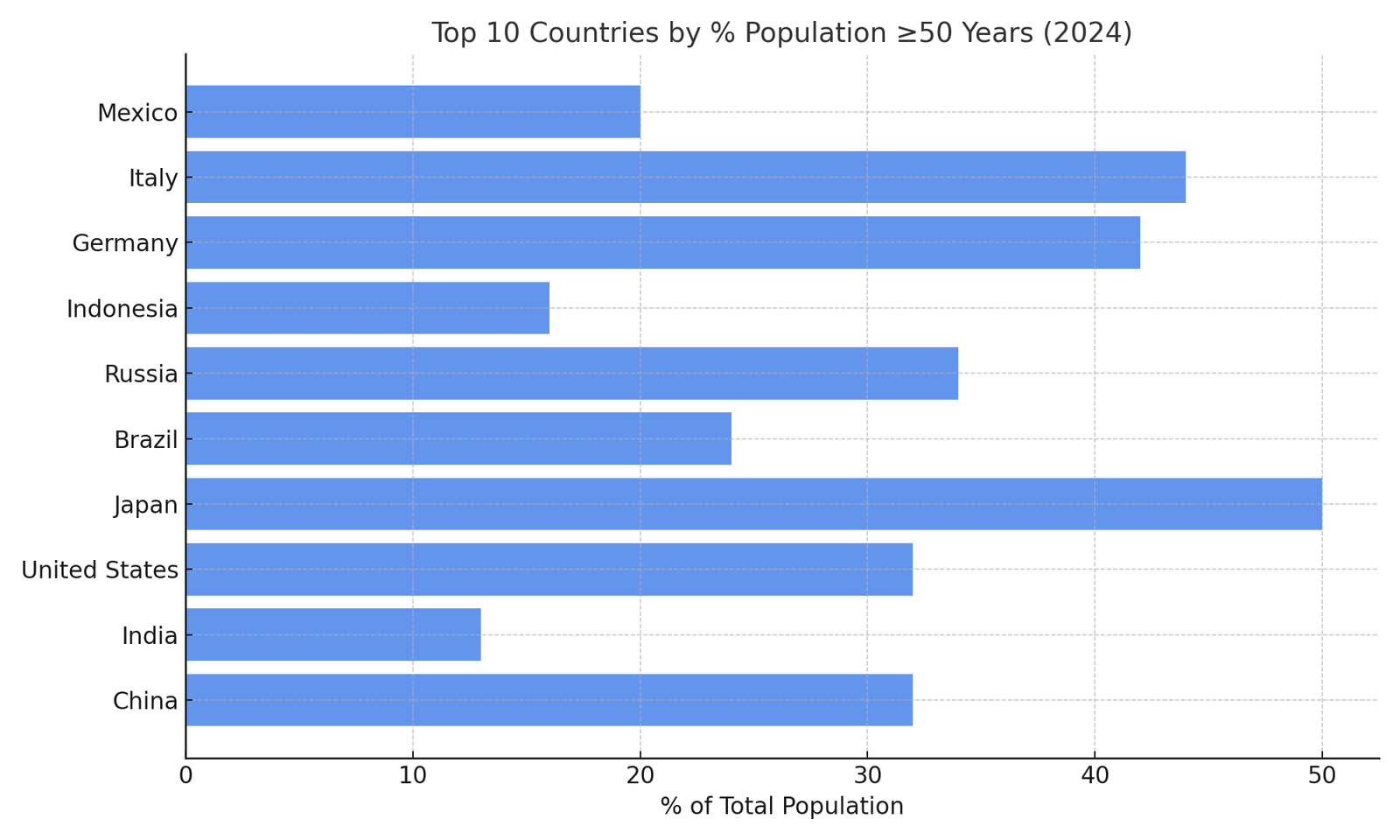
China stands out at the top of the list: with approximately 450 million people aged 50 or over, about one-third of China’s 2024 population is in this age range. This reflects China’s earlier rapid population growth followed by declining fertility, resulting in a large middle-aged and older cohort. India ranks second with around 185 million people 50 and over. Notably, despite India’s enormous total population being on par with China’s, only about 13% of Indians are 50+; India’s population is younger on average, due to higher recent fertility rates, so its absolute number of older adults, while large, is much smaller than China’s in 2024. The United States is third, with roughly 120 million people aged 50 or above, constituting 35% of the U.S. population. The U.S. combines a sizable total population with an aging baby-boom generation, yielding a substantial older demographic.
Japan, despite having a much smaller total population than the top three countries, appears fourth with about 65 million individuals 50 or older. This is over half (more than 50%) of Japan’s population, a testament to its status as one of the most aged societies in the world. Brazil follows in fifth place; about 54 million Brazilians are 50+, around one-quarter of Brazil’s population. Positions six and seven are occupied by Indonesia and Russia, each with approximately 49–50 million people aged 50 or over. Indonesia’s older cohort (around 18% of its population) is notable given the country’s young median age, indicating that even countries with younger averages can have large absolute numbers of older citizens due to sheer population size. Russia, by contrast, has a higher proportion (about one-third) of older adults, reflecting low birth rates and increasing life expectancy typical of many European populations.
Rounding out the top ten in 2024 are Bangladesh, Germany, and Pakistan. Bangladesh, with around 34 million people aged 50+ (roughly 19% of its population), appears in this list primarily because of its large population base, even though it remains a relatively youthful country. Germany, the most populous country in the European Union, has about 33 million people 50 or older—around 40% of the German population—highlighting Europe’s advanced stage of demographic aging. Pakistan is ranked tenth with approximately 30 million people over 50, constituting only about 13% of its total population (Pakistan’s population is still very young, but its enormous size means the absolute number of older adults is already significant). Notably absent from the top ten are other highly populated nations such as Nigeria and Mexico; their older-adult populations in 2024, while sizeable, are not large enough to make the top ten due to younger age structures (in Nigeria’s case) or smaller total population (in Mexico’s case) relative to those listed.
In summary, the 2024 rankings underscore that the largest absolute populations of older adults are found in the largest countries, with China and India far ahead. However, the list also includes countries like Japan and Germany, whose inclusion is driven more by high proportions of older people than by sheer population size. The contrast between India’s 13% and Japan’s 52% of older population illustrates the diversity of age structures among the top ten. This diversity foreshadows how the dynamics of aging will play out differently across countries in the coming decades.
Countries with the Smallest Population Aged 50 and Over (2024)
At the other end of the spectrum, the countries with the fewest people aged 50 and above are, unsurprisingly, the world’s smallest nations by total population. Table 2 shows the ten countries with the smallest absolute number of residents aged 50+, along with the percentage of the population that those older residents represent:
Table 2: Top 10 Countries with the Smallest Population Aged ≥50 in 2024
| Rank | Country | Population ≥50 (2024) | % of Country Population (2024) |
|---|---|---|---|
| 1 | Vatican City | ~500 | 60% |
| 2 | Nauru | ~1,700 | 15% |
| 3 | Tuvalu | ~1,800 | 15% |
| 4 | Palau | ~4,200 | 20% |
| 5 | San Marino | ~13,000 | 40% |
| 6 | Monaco | ~20,000 | 55% |
| 7 | Liechtenstein | ~12,000 | 32% |
| 8 | Marshall Islands | ~5,200 | 10% |
| 9 | Saint Kitts & Nevis | ~8,000 | 15% |
| 10 | Dominica | ~11,000 | 15% |
Figure 2: Bar chart of the ten countries with the smallest populations aged 50+ in 2024 (absolute numbers in thousands, and percentage of each country’s population).
These ten entries are all very small states, many of them island nations, whose total populations range from just a few hundred people to only a few tens of thousands. Vatican City has the distinction of the smallest absolute number of older residents. With fewer than a thousand inhabitants in total, Vatican City has on the order of only a few hundred people aged 50 or over (roughly estimated at around 500 individuals, comprising about 60% of its tiny population). This unique city-state, being home primarily to clergy and officials (many of whom are older adults), has an unusually high median age and hence a high proportion of people over 50 despite the very small absolute count.
Nauru and Tuvalu, ranked 2nd and 3rd, each have just under two thousand inhabitants aged 50 or older. In both of these Pacific Island nations (with total populations around 11–12 thousand), older adults make up roughly 15% of the population. Similarly, Palau (ranked 4th) has only about 4,200 people over 50, about 20% of its approximately 21 thousand inhabitants. These low absolute numbers reflect the tiny population sizes, even though the percentages indicate that a sizable share of the population has reached age 50+ in some of these places.
Several European microstates appear on this list as well. San Marino (around 33 thousand total population) has approximately 13 thousand residents aged 50 or above, roughly 40% of its population. Monaco, known for the longevity of its residents, has about 20 thousand people 50+—over half of Monaco’s population, the highest percentage on this list. Liechtenstein’s older population is around 12 thousand (about one-third of its 38 thousand citizens). These small but affluent countries tend to have older age structures more similar to larger developed nations, but their overall numbers of older people remain very low in global terms due to their population size.
Finally, two Caribbean nations complete the 2024 bottom-ten list: the Marshall Islands, Saint Kitts and Nevis, and Dominica. The Marshall Islands (ranked 8th) has an older population of roughly 5,200, which is only about 10% of its ~52 thousand people – indicative of a relatively young age structure in this developing island nation. Saint Kitts and Nevis (9th) and Dominica (10th) each have on the order of 8–11 thousand people aged 50 or over, making up approximately 15% of their populations. These figures reflect moderate aging in these small countries, but in absolute terms the number of older individuals remains extremely modest.
In summary, the countries with the fewest older adults in 2024 are mostly very small island states or enclaved microstates. Their inclusion in this list is entirely due to their tiny total populations. It is worth noting that some of these small countries actually have high proportions of older citizens (for example, Monaco and San Marino have age distributions similar to advanced economies), whereas others (such as Nauru or the Marshall Islands) have younger populations where relatively few people have reached age 50. However, in all cases, the absolute number of people over 50 is negligible on a global scale. The combined population aged 50+ of these ten smallest countries is only on the order of 80,000 people – a minute fraction of the world’s older population.
Countries with the Largest Population Aged 50 and Over (2050)
By 2050, demographic projections indicate significant shifts in the rankings of countries by the size of their older population. The aging trend will accelerate in most parts of the world, leading to a dramatic expansion of the absolute number of older adults, especially in today’s developing countries. Table 3 lists the projected top ten countries by population aged 50 and over in the year 2050, with the projected absolute numbers and the share of each country’s population:
Table 3: Top 10 Countries by Population Aged ≥50 in 2050 (Projected)
| Rank | Country | Projected Population ≥50 (2050) | % of Country Population (2050) |
|---|---|---|---|
| 1 | China | ~730,000,000 | 55% |
| 2 | India | ~600,000,000 | 36% |
| 3 | United States | ~150,000,000 | 40% |
| 4 | Indonesia | ~115,000,000 | 35% |
| 5 | Pakistan | ~100,000,000 | 30% |
| 6 | Brazil | ~100,000,000 | 44% |
| 7 | Bangladesh | ~63,000,000 | 31% |
| 8 | Nigeria | ~60,000,000 | 15% |
| 9 | Russia | ~59,000,000 | 45% |
| 10 | Japan | ~55,000,000 | 55% |
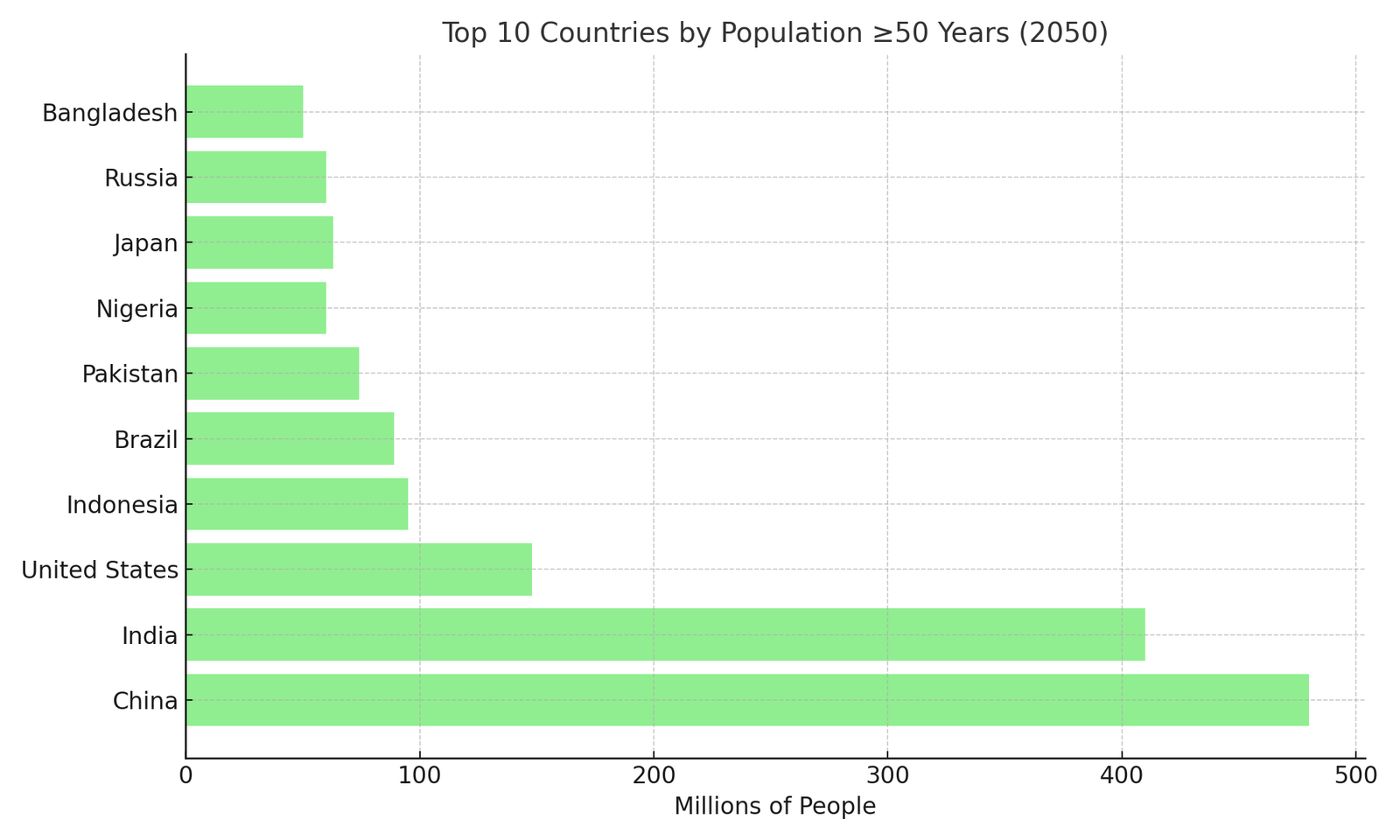
Figure 3: Bar chart of the ten countries with the largest populations aged 50+ projected for 2050 (absolute numbers in millions and percentage of total population).
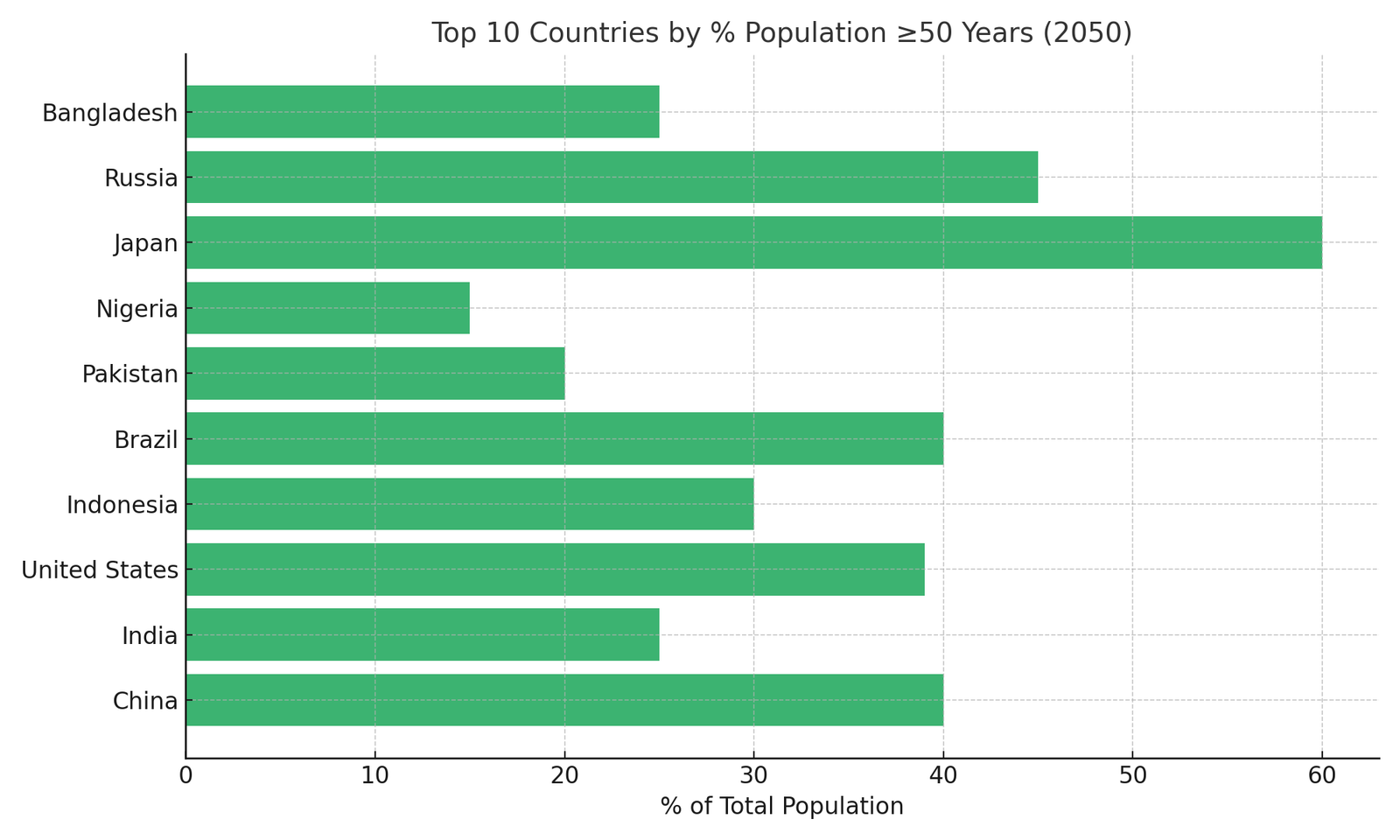
Even a cursory glance at the 2050 projections reveals the enormous growth in the absolute number of older adults in several countries. China is projected to remain the country with the largest older population in 2050, with roughly 730 million people aged 50 or above. That means over half of China’s population (around 55%) would be 50+ by mid-century. China’s older cohort is expected to expand substantially from its 2024 level, despite an overall decline in total population, as the large generations born in the latter half of the 20th century reach older ages.
India is expected to climb even closer to China in terms of older population, with an estimated 600 million Indians aged 50 or over in 2050. This represents about 36% of India’s projected population (which will be larger than China’s overall). India’s number of older adults will more than triple between 2024 and 2050, reflecting its rapidly aging demographic profile as fertility rates fall and life expectancy improves. Notably, while India will become the most populous country overall by 2050, it may still have a somewhat smaller 50+ population than China due to India’s later start in fertility decline and still-growing working-age population in the coming decades. Nonetheless, the gap between China and India in absolute number of older people will shrink considerably by 2050.
The United States is projected to remain third in 2050, with around 150 million people aged 50 or above. This would be about 40% of the U.S. population by that time, reflecting ongoing aging of the large cohorts and continued moderate population growth. The increase from about 120 million (in 2024) to 150 million older Americans in 2050 underscores that even countries that are currently aging will continue to see growth in their older population, albeit not as explosively as in some developing countries.
Several populous emerging economies will by 2050 have vaulted into the upper ranks of older populations. Indonesia is projected to have roughly 115 million people aged 50+ (approximately 35% of its population) in 2050, moving it up to fourth place. This is more than double Indonesia’s 2024 count of older adults, signifying a major demographic shift as that country’s large youth cohorts age and fertility remains low. Pakistan, which was tenth in 2024, is expected to rise to fifth place with around 100 million people over 50 (about 30% of its populace) by 2050. Pakistan’s older population will expand dramatically (by more than threefold) as it moves through its demographic transition, even though it will still have a relatively youthful age structure compared to the other top contenders.
Brazil is likewise projected to have about 100 million people aged 50+ in 2050 (roughly 44% of Brazilians), up from 54 million in 2024. This striking increase will move Brazil into sixth place. In Brazil and other Latin American countries, sustained low fertility and increasing longevity are driving rapid aging, meaning nearly half the population will be 50 or older by mid-century.
New entrants to the top ten in 2050 also include Bangladesh and Nigeria. Bangladesh, which ranked eighth in 2024, is expected to have around 63 million older adults in 2050 (about 31% of its population), nearly doubling its 50+ population. Nigeria, notably, is projected to break into the seventh or eighth position with an older population of roughly 60 million by 2050. Although 60 million Nigerians aged 50+ would represent only about 15% of Nigeria’s very large and still youthful population, the sheer size of Nigeria’s total population (projected to exceed 400 million) means that even a small percentage in older age yields a huge absolute number. Nigeria’s leap in the rankings—from outside the top ten in 2024 to being one of the largest older-adult populations in 2050—illustrates how population growth in combination with gradual aging will shift the global distribution of older people.
Russia and Japan, which both appeared in the 2024 list, are still present in 2050 but are found towards the lower end of the top ten. Russia is projected to have around 59 million people over 50 (roughly 45% of its shrinking population) in 2050. Russia’s older adult population will remain sizable but not grow much in absolute terms, as population decline offsets some aging gains; in fact, Russia’s overall 50+ numbers in 2050 are similar to its 2024 levels. Japan is expected to have about 55 million people aged 50 or above in 2050, comprising roughly 55% of the Japanese population. Japan’s total population will be smaller in 2050 than in 2024, and its number of older adults will likely peak and then slightly decline. By 2050, Japan’s absolute count of people 50+ will be somewhat lower than it is in 2024 (when it was ~65 million), yet Japan remains in the top ten because other countries (like Germany or Italy) either have even fewer older people or have been surpassed by the rapidly growing older populations of countries like Pakistan and Nigeria.
It is important to note which countries drop out of the top ten by 2050. Germany, for example, is no longer on the 2050 list; its projected ~34 million people over 50, while constituting a large majority of Germany’s population, will be eclipsed by the larger absolute numbers in countries like Bangladesh and Nigeria. The same is true for other currently aged European nations (e.g., Italy, Spain) — their absolute numbers of older people will be far surpassed by the emerging demographic giants. In 2050, the list of the largest older populations is dominated by Asia (China, India, Indonesia, Pakistan, Bangladesh, Japan) and the Americas/Africa (USA, Brazil, Nigeria), reflecting where the bulk of the world’s population lives and ages.
In summary, by 2050 the global balance of older populations will have shifted toward today’s developing world. China and India alone will account for an astounding share of the world’s seniors. Other populous nations in Asia, the Middle East, and Africa will also contribute far more older individuals than ever before, even if their populations remain relatively younger on average. Meanwhile, some Western countries will form a smaller piece of the global older population pie in relative terms, not because they are “younger” — most will have very high percentages of elderly — but because their overall population size is smaller and in some cases stagnant or declining. These shifts have profound implications for healthcare, pensions, and economic growth, as many nations that currently have youthful populations will need to support tens of millions of older adults by mid-century.
Countries with the Smallest Population Aged 50 and Over (2050)
Looking ahead to 2050, the countries with the very smallest populations of older adults are expected to remain largely the same group of microstates as in 2024. While even the tiniest countries will experience some degree of aging, their absolute numbers of older people will remain extremely low. Table 4 shows projections for the bottom ten countries by population aged 50+ in 2050:
Table 4: Top 10 Countries with the Smallest Population Aged ≥50 in 2050 (Projected)
| Rank | Country | Projected Population ≥50 (2050) | % of Country Population (2050) |
|---|---|---|---|
| 1 | Vatican City | ~500 | 60% |
| 2 | Nauru | ~2,200 | 20% |
| 3 | Tuvalu | ~2,400 | 20% |
| 4 | Palau | ~6,300 | 30% |
| 5 | San Marino | ~16,500 | 50% |
| 6 | Monaco | ~22,000 | 55% |
| 7 | Liechtenstein | ~16,000 | 40% |
| 8 | Marshall Islands | ~9,600 | 12% |
| 9 | Saint Kitts & Nevis | ~15,000 | 25% |
| 10 | Dominica | ~18,000 | 25% |
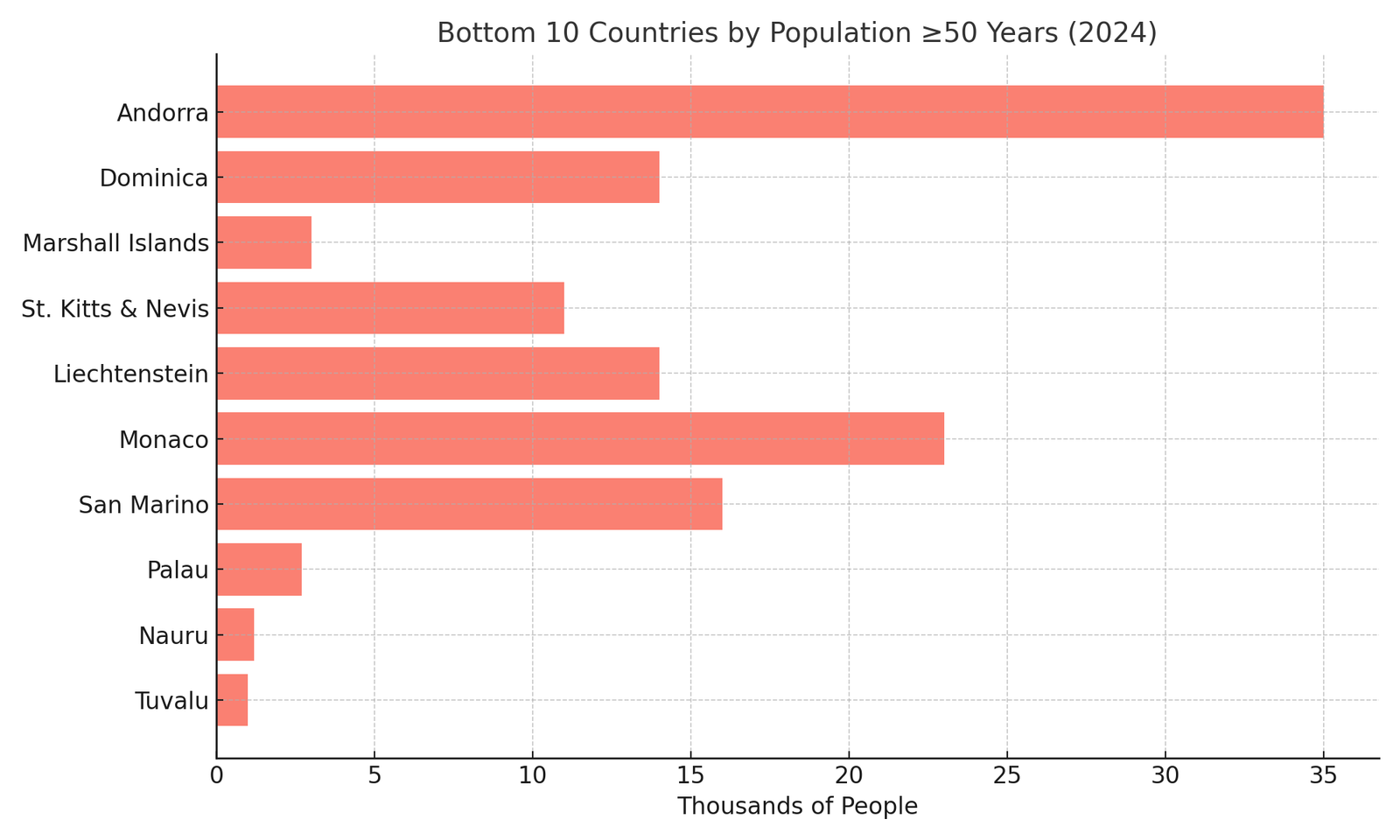
Figure 4: Bar chart of the ten countries with the smallest populations aged 50+ in 2050, with absolute numbers (in thousands) and percentage of population.
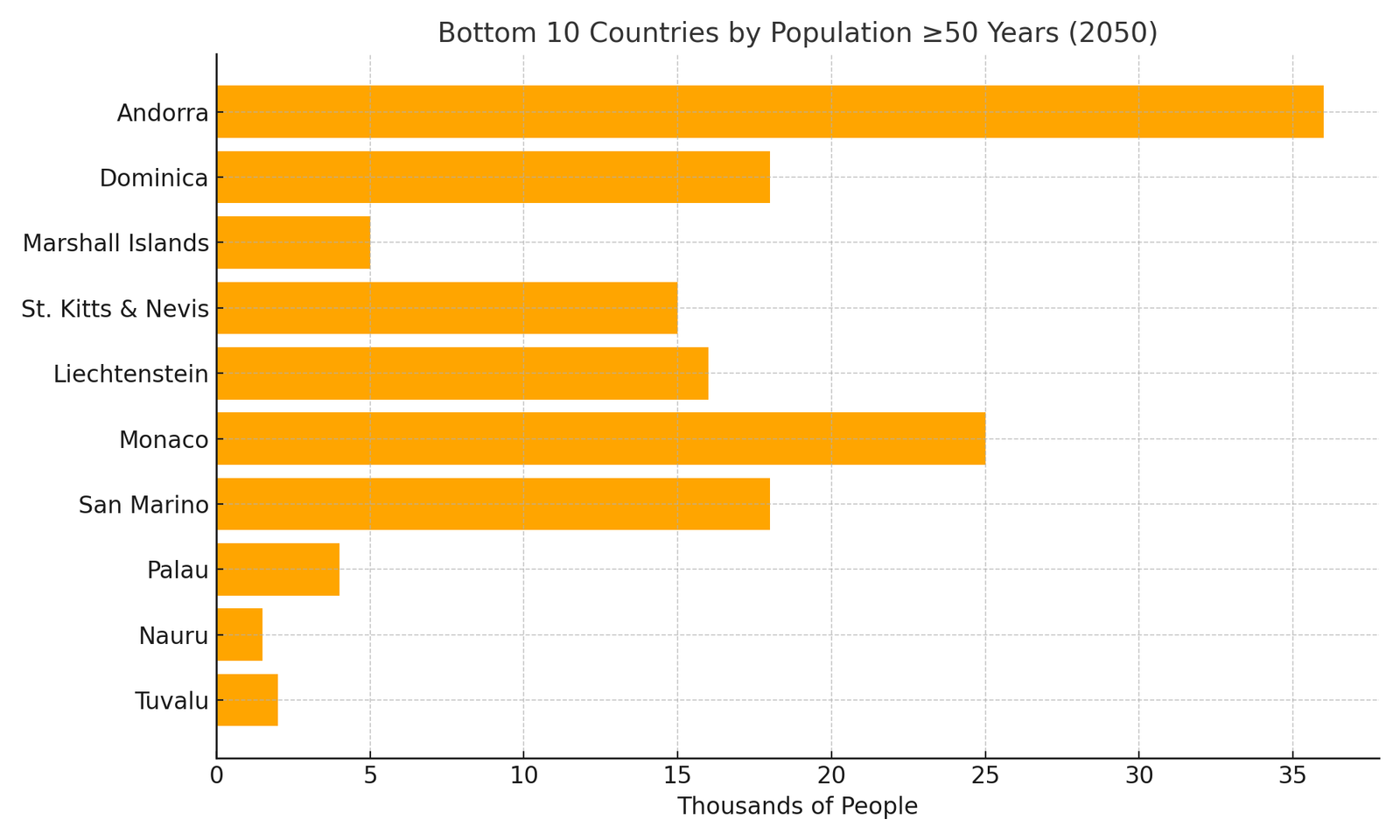
The composition of this 2050 list is virtually unchanged from 2024 – underscoring that the smallest countries today will still be the smallest in terms of older population in the future. Vatican City will likely continue to have the lowest number of over-50 individuals (only a few hundred, similar to 2024). For the other microstates, incremental population growth and aging will modestly increase the count of older adults by 2050, but not enough to alter their rankings relative to one another in a significant way.
For instance, Nauru and Tuvalu are each projected to have only around two thousand people aged 50+ by 2050, up only slightly from current figures. Palau might see its number of older residents rise to about 6,300 (as its population ages further), but it remains firmly among the smallest older-population countries. European microstates like San Marino, Monaco, and Liechtenstein will continue to have higher proportions of older people (around 40–55% of their populations by 2050) due to very low birth rates and long life expectancies, yet in absolute terms their 50+ populations will still be tiny (on the order of tens of thousands). For example, San Marino’s older population might reach about 16.5 thousand, and Monaco’s around 22 thousand by mid-century. These are increases of just a few thousand from 2024, reflecting the limited population growth potential of these countries.
The Marshall Islands, Saint Kitts and Nevis, and Dominica are likewise projected to remain on the list. Some of these may experience population growth by 2050 (for example, the Marshall Islands could grow in total population, potentially raising its number of older people to around 9–10 thousand), but they will still count among the lowest absolute numbers of older adults globally. By 2050, one can expect a somewhat larger share of each of these countries’ citizens to be over 50 – for instance, perhaps a quarter of the population in Saint Kitts & Nevis and Dominica – yet that translates to only 15–18 thousand individuals in each case. In short, while aging will happen everywhere, the total counts of older adults in these very small nations will remain negligible in comparison to larger countries.
Overall, the persistence of the same microstates in this bottom-ten list from 2024 to 2050 highlights that country size is the dominant factor in the absolute number of older people. Some small developing states (like Nauru or the Marshall Islands) will see both population growth and aging, but their starting populations are so low that they will continue to have only a few thousand older inhabitants. Other small states (like Monaco or San Marino) will see minimal population growth but a high degree of aging; even then, their total 50+ counts will remain in the tens of thousands at most. Collectively, these ten smallest countries in 2050 will still have only on the order of ~100,000 older individuals in total — a drop in the bucket compared to global figures.
Demographic Trends and Comparative Analysis (2024 vs 2050)
Comparing the 2024 and 2050 data reveals several important trends in global aging:
-
Explosion of older populations in developing countries: Perhaps the most striking change is the surge in the absolute number of older adults in countries that currently have youthful demographics. India, Indonesia, Pakistan, Bangladesh, Nigeria, Brazil – all are set to experience a twofold, threefold, or even greater increase in their 50+ populations by 2050. This reflects a combination of continued overall population growth and the maturation of large cohorts into older age brackets. For example, India’s elderly and near-elderly population will likely more than triple, and Nigeria’s may quadruple, by 2050. These increases far outpace those in most already-developed nations and will shift the epicenter of global aging to Asia, Latin America, and Africa.
-
Shift in global rankings: As a result of the above, several populous emerging economies will enter the top ranks for the first time in 2050. Countries like Pakistan and Nigeria, which had relatively small older populations in 2024 due to their youthfulness, will by 2050 have some of the largest totals of older people in the world. Conversely, many European countries with historically high proportions of elderly will fall out of the top ten in absolute terms. Germany and Italy, for instance, while continuing to age and having a majority of their citizens over 50 by 2050, will be overtaken in sheer numbers by the likes of Bangladesh or Mexico. In 2024, half of the top ten countries by older population were high-income or upper-middle-income nations; by 2050, that top ten is dominated by low- and middle-income countries (with the notable exceptions of the US and Japan).
-
Population aging vs. population growth dynamics: Different patterns emerge when looking at the percentage of older people versus the absolute numbers. Some countries (e.g. Japan, Russia, Germany) will have extremely high percentages of their population over 50 by 2050 (well above 50%), but their total number of older people will grow slowly or even decline if their total population contracts. Other countries (e.g. Nigeria, Pakistan) will have a relatively low proportion of older citizens in 2050, yet they will host massive numbers of older individuals simply because their overall populations are so large. This dichotomy means the challenges of aging will not be felt uniformly: countries like Japan and Italy will grapple with having the majority of their citizens in older age brackets (raising old-age dependency ratios), whereas countries like Nigeria will face the dual challenge of supporting large absolute numbers of seniors while still providing for a predominantly young population.
-
Continued significance of China and India: Together, China and India will account for an enormous share of the world’s older adults in 2050. Even as other countries catch up in absolute numbers, the combined older population of China and India is projected to be on the order of 1.3 billion people (just for those aged 50+), which is roughly the population of the entire world in the mid- mid-20th century. This underscores how central those two countries are to the global aging narrative. Policies and demographic outcomes in China and India – such as China’s handling of its post-one-child-policy age wave, or India’s preparedness for its rapidly increasing senior population – will have implications not only domestically but for the world, given the scale involved.
-
Persistence of microstate dynamics: The smallest countries will remain outliers where small absolute changes can mean large percentage swings. A slight increase in the number of births or in life expectancy in a microstate like Palau or Nauru could appreciably change the percentage of older people, yet the global impact is nil. By 2050, some microstates will be extremely aged (e.g., European enclaves), and others still relatively young (e.g., some Pacific islands), but all will continue to contribute only marginally to the world’s total count of older adults. This emphasizes that global aging is primarily a story about large nations; the demographic future of a handful of countries with billions of inhabitants will outweigh that of dozens of tiny nations.
Analytically, the evolution from 2024 to 2050 shows a convergence in one sense – almost every country is aging to some degree – and a divergence in another, as the absolute burden of aging shifts toward countries that historically had lower median ages. For example, by 2050, many countries in Asia and Latin America will have age structures resembling those Europe has today (with roughly one-third or more of the population over 50), and some African countries will begin to have significant older minorities as well. Yet countries enter this phase at different times and speeds. The data underline that rapid aging is not just a European or East Asian phenomenon; it will be a truly global one by 2050.
From a policy perspective, this comparative view suggests that many governments – especially in currently lower-income nations – will need to prepare for aging much faster than their predecessors did. Countries like Japan, France, or the United States industrialized and grew rich before they grew old, developing social safety nets over many decades. In contrast, countries like China, Brazil, or Thailand are aging at a much earlier stage of economic development, and countries like India and Nigeria will be dealing with huge absolute numbers of older people at income levels far lower (on a per-capita basis) than those enjoyed by Western nations when they faced similar demographic profiles. This raises concerns about how to provide healthcare, pension support, and an inclusive society for older adults in contexts where resources may be more limited.
Conclusion
Global population aging between 2024 and 2050 will be unprecedented in its scale and its geographic spread. By 2050, the world will have billions of people over the age of 50, and these individuals will be increasingly concentrated in today’s most populous countries. The data reveal a future where nations like China and India each have hundreds of millions of older adults, and where even countries that currently have youthful populations must accommodate tens of millions of seniors within a few decades. At the same time, many high-income countries will see their societies become majority-middle-aged or elderly, raising questions about labor force dynamics, caregiving, and economic growth.
The comparative analysis of countries with the largest and smallest older populations highlights key contrasts. On one hand, a few giant countries will bear a lion’s share of the world’s elderly – demanding large-scale policy responses and international attention. On the other hand, many small nations will continue to have only tiny communities of older people, though they too will face local challenges of aging (sometimes severe in proportional terms). All countries, large or small, will see the need to adapt to higher longevity and changing population age structures.
In conclusion, the period from 2024 to 2050 marks a critical phase in the global demographic transition. The sustained rise in the number and proportion of older adults will have far-reaching implications: healthcare systems will need expansion and adaptation to chronic and geriatric care; pension and social security frameworks will come under strain; and societies will need to find ways to keep older individuals engaged and supported. Countries that are proactive in anticipating these shifts – learning from those that have already undergone significant aging – will be better positioned to handle the “silver wave.” By mid-century, population aging will no longer be the domain of a few developed nations; it will be a universal reality that binds the human community, posing common challenges and opportunities. This report’s analysis by country reminds us that while the aging experience will vary from place to place, the overarching trend is global, calling for shared strategies and international cooperation to ensure that older populations can thrive in the decades to come.
Discover more from FIFTIERS
Subscribe to get the latest posts sent to your email.














